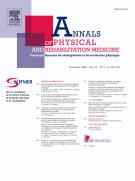Muscle assessment in healthy teenagers : Comparison with teenagers with low back pain - 19/06/08
 , R. Bard, A. Pujol, A. Combey, D. Boussard, C. Begue, A.M. Salghetti
, R. Bard, A. Pujol, A. Combey, D. Boussard, C. Begue, A.M. SalghettiAbstract |
Objectives |
To describe muscle parameters in healthy teenagers and compare them to teenagers with chronic low back pain.
Methods |
A comparative study of 276 control teenagers and 51 teenagers with chronic low back pain (CLBP), benefiting from a specific treatment, 14.5 years average age. The control group is made up of teenagers without back pain and teenagers who reported some back pain when we asked them, but without specific treatment. The results to four static tests assessing trunk flexors, trunk extensors, hip extensors and quadriceps endurance are statistically compared. In the control group, associations between different clinical measures and possible back pain are looked for.
Results |
The two groups are homogeneous, concerning age, weight, standing height, sitting height and BMI (p>0,05). Low back pain is more common in girls, either in the control group (n=48; 69% of girls) or in the group with CLBP (n=51; 78%). CLBP is associated with a poor endurance strength of the trunk extensors (median: 2min 31s in the control group to 1min 45s in the CLBP), with hip extensors weakness (median: 2min 20s in the control group to 1min 24s in the CLBP), and with quadriceps weakness (median: 2min 39s in the control group to 1min 20s in the CLBP), (p=0.000). No significant difference was found between trunk flexors endurance in the two groups (median: 2min 11s in the control group to 2min 13s in the CLBP). In the control group, 48 teenagers reported back pain “often”, “very often” or “all the time”; no links were found between pain and muscle flexibility, measured with finger-floor distance, heel-cheek distance, and popliteal angle. Only the sitting height was found statistically higher (p=0.003) in the control teenagers who reported back pain (87cm) related to the ones who have no pain (85cm). Sport influences global strength in lower limbs and changes the ratio of quadriceps to hip extensors, in favour of quadriceps. Neither pain nor the ratio of trunk flexors to trunk extensors are modified by sport. There is a linear relation between Shiradoʼs and Sorensenʼs logarithmic values: it is consequently possible to predict the Shirado value when we have the Sorensen one. Trunk extensors, hip extensors and quadriceps endurance is lower in the CLBP group, 14.5 years of age.
Le texte complet de cet article est disponible en PDF.Keywords : Teenagers, Low back pain, Muscle endurance, Clinical measures, Comparative study
Plan
Vol 51 - N° 4
P. 274-283 - mai 2008 Retour au numéroBienvenue sur EM-consulte, la référence des professionnels de santé.
L’accès au texte intégral de cet article nécessite un abonnement.
Déjà abonné à cette revue ?

